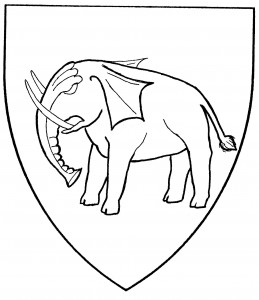The elephant is a gigantic beast characterized by its tusks, ears, and prehensile trunk; some early emblazons show it with cloven hooves as well. It was considered a symbol of modesty and chastity by the medievals. As an heraldic charge, the elephant dates from c.1340, in the canting arms of the Grafs von Helfenstein [Zurich 79].
The elephant is statant by default; its “proper” tincture is grey with argent tusks. It is sometimes shown with a castle or tower on its back, such as recorded in the Visitation of Wales, 1530 [Woodcock & Robinson 149]; in such a case, the fact must be explicitly blazoned. The castle is said to recall war elephants with howdahs, described by Alexander the Great when he tried to conquer India; if the elephant’s tower is actually drawn as a howdah, its use carries a step from period practice.
Tristan d’Alsace bears: Azure, three elephants statant argent.
‘Abd al-Hakim ibn ‘Abd al-Rahman Shaddad al-Tomüki bears: Argent, an elephant rampant sable maintaining in its trunk a coronet gules.
Edmund Foxe bears: Sable, an elephant argent maintaining atop its back a tower, a bordure embattled Or.
Katherine Meade bears as a badge: An elephant rampant ermine bearing on its back a howdah gules.
